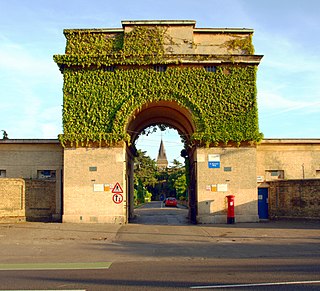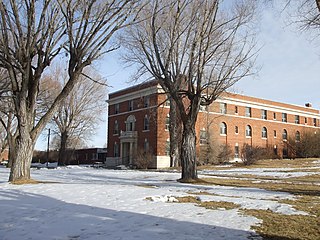
Wymondham is a market town and civil parish in the South Norfolk district of Norfolk, England, 12 miles (19 km) south-west of Norwich off the A11 road to London. The River Tiffey runs through. The parish, one of Norfolk's largest, includes rural areas to the north and south, with hamlets of Suton, Silfield, Spooner Row and Wattlefield. It had a population of 14,405 in 2011, of whom 13,587 lived in the town itself.

The Royal Earlswood Hospital, formerly The Asylum for Idiots and The Royal Earlswood Institution for Mental Defectives, in Redhill, Surrey, was the first establishment to cater specifically for people with developmental disabilities. Previously they had been housed either in asylums for the mentally ill or in workhouses.

Norwich North is a constituency represented in the House of Commons of the UK Parliament since 2009 by Conservative Chloe Smith.

Thorpe St Andrew is a town and civil parish in the Broadland district of Norfolk, England. It is situated on the River Yare, two miles east of the centre of Norwich, and is outside the boundary of the city. The civil parish has an area of 708 ha and had a population of 14,556 at the 2011 census; this was an increase from the 2001 figure of 13,762. It is the administrative headquarters of the Broadland district council.

Cane Hill Hospital was a psychiatric hospital in Coulsdon in the London Borough of Croydon. The hospital motto was "Aversos compono animos". The hospital was built in the 1880s, but from the 1960s its use was starting to decline and it eventually closed completely in the 2000s. The former site is owned by GLA Land and Property.

Claybury Hospital was a psychiatric hospital in Woodford Bridge, London. It was built to a design by the English architect George Thomas Hine who was a prolific Victorian architect of hospital buildings. It was opened in 1893 making it the Fifth Middlesex County Asylum. Historic England identified the hospital as being "the most important asylum built in England after 1875".

St Bernard's Hospital, also known as Hanwell Insane Asylum and the Hanwell Pauper and Lunatic Asylum, was an asylum built for the pauper insane, opening as the First Middlesex County Asylum in 1831. Some of the original buildings are now part of the headquarters for the West London Mental Health NHS Trust (WLMHT).

Wicklewood is a village and civil parish in the South Norfolk district of Norfolk, England. It is located 11 miles (18 km) west of Norwich next to the market town of Wymondham, neighbouring the villages of Deopham, Hackford and Kimberley. It covers an area of 8.75 km2 (3.38 sq mi) and had a population of 886 in 345 households at the 2001 census, which had increased to 922 at the 2011 Census.

Asylum architecture in the United States, including the architecture of psychiatric hospitals, affected the changing methods of treating the mentally ill in the nineteenth century: the architecture was considered part of the cure. Doctors believed that ninety percent of insanity cases were curable, but only if treated outside the home, in large-scale buildings. Nineteenth-century psychiatrists considered the architecture of asylums, especially their planning, to be one of the most powerful tools for the treatment of the insane, targeting social as well as biological factors to facilitate the treatment of mental illnesses. The construction and usage of these quasi-public buildings served to legitimize developing ideas in psychiatry. About 300 psychiatric hospitals, known at the time as insane asylums or colloquially as “loony bins” or “nuthouses,” were constructed in the United States before 1900. Asylum architecture is notable for the way similar floor plans were built in a wide range of architectural styles.
William Thorold was an eminent 19th-century millwright, architect and civil engineer in Norwich, Norfolk, England.

Lancaster Moor Hospital, formerly the Lancaster County Lunatic Asylum and Lancaster County Mental Hospital, was a mental hospital in Lancaster, Lancashire, England, which closed in 2000.

Hellesdon Hospital is a mental health facility in Hellesdon, Norfolk, England. It is managed by Norfolk and Suffolk NHS Foundation Trust.

Coney Hill Hospital was a mental health facility in Gloucester, England.

Shelton Hospital was a mental health facility in Shelton, Shropshire, England. The main building survives and it is a Grade II listed building.

St Clement's Hospital was a mental health facility at Foxhall Road in Ipswich, Suffolk, England.

St Francis Hospital was a mental health facility in Haywards Heath, West Sussex, England. The main building survives and is a Grade II listed building.

St George's Hospital is a mental health facility in Stafford, Staffordshire, England. The main building is no longer in use but survives and is a Grade II listed building.

St James' Hospital is a mental health facility at Milton, Portsmouth, Hampshire, England. It is managed by Solent NHS Trust. The main structure is a Grade II listed building.

St John's Hospital was a mental health facility at Stone, Buckinghamshire, England.




















